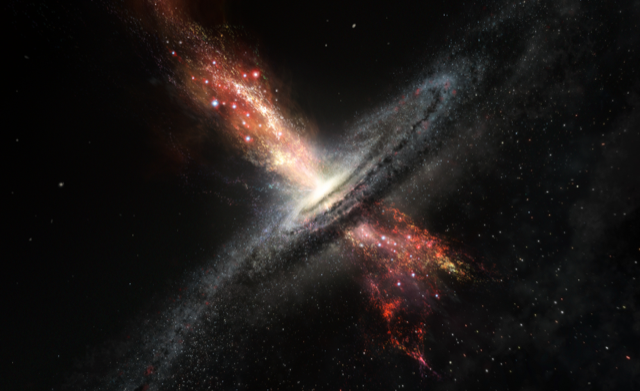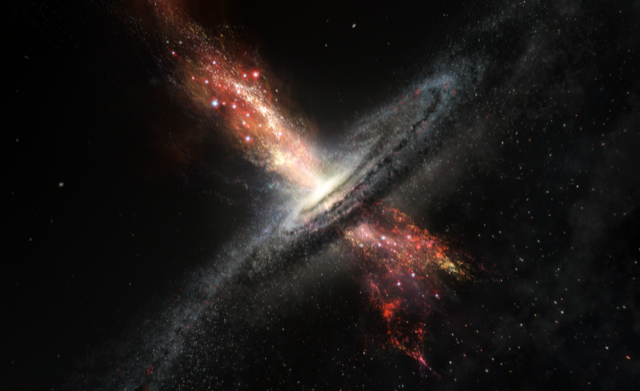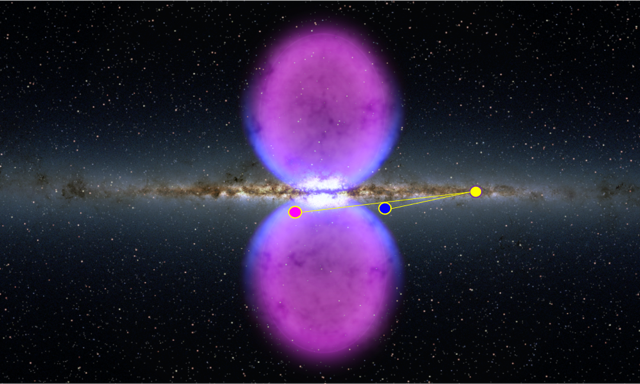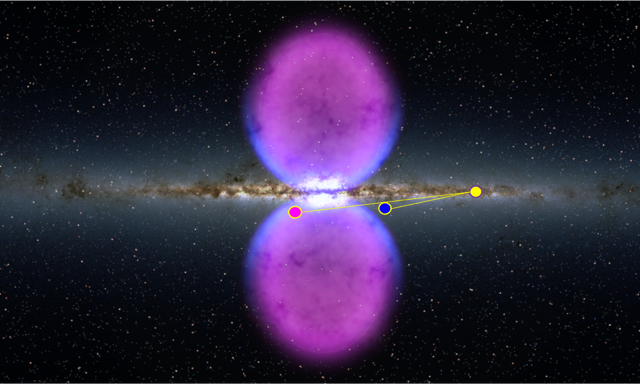Blowin’ in the Galactic Wind
Fast-moving ionized gases emanate from the center of our Galaxy, flowing perpendicular to the spiral disk. Teasing out the properties of this “Galactic wind” offers a glimpse into galactic evolution. Now, Frances Cashman of the Space Telescope Science Institute, Maryland, and her colleagues report two high-velocity clouds of molecular hydrogen (H2) actively being expelled from the Milky Way’s Galactic disk. The unexpected detection of this nonionized gas within the flow of the Galactic wind has implications for the shuttling of star formation material out of the Galaxy.
The Galactic wind is driven by two sources in the Galactic Center: a supermassive black hole and a region of intense star formation. The black hole is associated with jets and other violent activity, while the star formation produces massive stars that end their lives via supernova explosions. Those explosions provide energy for the wind, while also seeding it with heavy elements (so-called “metals”) that are the result of nuclear reactions in stars. Metals are important ingredients for subsequent generations of stars, so astronomers are keen on tracking the movement of metals and other star-forming materials.
The Galactic wind circulates gas between the Galaxy’s disk and its outer envelope, or “halo.” As a consequence, the wind can push material out of the Galaxy, reducing its supply of star-forming ingredients. However, researchers are unsure about the material being ejected—what is the mix of neutral, ionized, and molecular phases in the wind? “Studying these multiphase gas flows in our own Galaxy helps to inform us about how galaxies evolve,” explains Cashman.
Neutral atomic and ionized gases have been observed within the Galactic wind. More surprisingly, recent observations found evidence for dense clusters of cold carbon monoxide (CO) in the Galactic wind, confirming the presence of cold molecular clouds. Such high-velocity molecular gas is rarely detected anywhere in the galactic halo, much less near the center—where it would be expected to quickly dissipate because of the force of the wind. To confirm that molecular clouds can survive in the wind, researchers would like to observe H2, which is the most abundant molecule in the Universe and is a major component of star formation. But unlike CO, H2 cannot easily be measured from the ground. Cashman and her colleagues have now managed to spot H2 in the Galactic wind by sifting through ultraviolet data from a satellite.
Using archival stellar spectra from NASA’s Far Ultraviolet Spectroscopic Explorer, a satellite that operated from 1999 through 2007, Cashman and her colleagues directly detected two clouds of H2 gas, both at approximately 1 kpc (3000 light years) below the Galactic Center. The molecular hydrogen was visible through the absorption lines that it produced in a background star located behind the Galactic Center. The researchers did not detect these lines in another star located in front of the Galactic Center, implying that the clouds are in the wind region. “Molecular gas was a missing piece of the puzzle of the nuclear wind and its presence shows that cold clouds can survive in the high-temperature Galactic Center environment,” says Cashman.
“The presence of this gas in the wind is important for the removal and dispersion of star-forming material from the Galactic disk,” says Filippo Fraternali, an astrophysicist at the University of Groningen in the Netherlands. “Determining how this is happening is a critical piece of information to understand the cycle of gases in and out of galaxies and the impact of galactic winds.”
To investigate the origin of the H2 clouds, the researchers analyzed the molecular absorption lines and determined the radial velocity with respect to Galactic Center. They found that the clouds have a radial velocity similar to the tilted section of the disk, implying that the clouds are moving at an interface between the disk and the nuclear wind.
Previous observations determined that the atomic gas associated with the H2 clouds has a thermal pressure up to 25 times higher than the mean pressure reported in the Galactic disk interstellar medium. That high pressure could be the result of compression by an outflowing hot wind. Cashman suggests that both H2 clouds formed in a cold, quiescent disk environment, but the nuclear wind broke them apart. “Our observations reveal that the nuclear wind is actively expelling cold gas from the disk and into the halo,” says Cashman.
“How molecular gas can be accelerated in a galactic wind is not well understood theoretically,” Fraternali adds. Researchers want to learn more about our Galaxy’s wind to gain insights into winds blowing from other galaxies. Detailed observations could lead to improved models of how winds form, how much mass they contain, and how they affect galactic evolution.
–Rachel Berkowitz
Rachel Berkowitz is a Corresponding Editor for Physics Magazine based in Vancouver, Canada.







